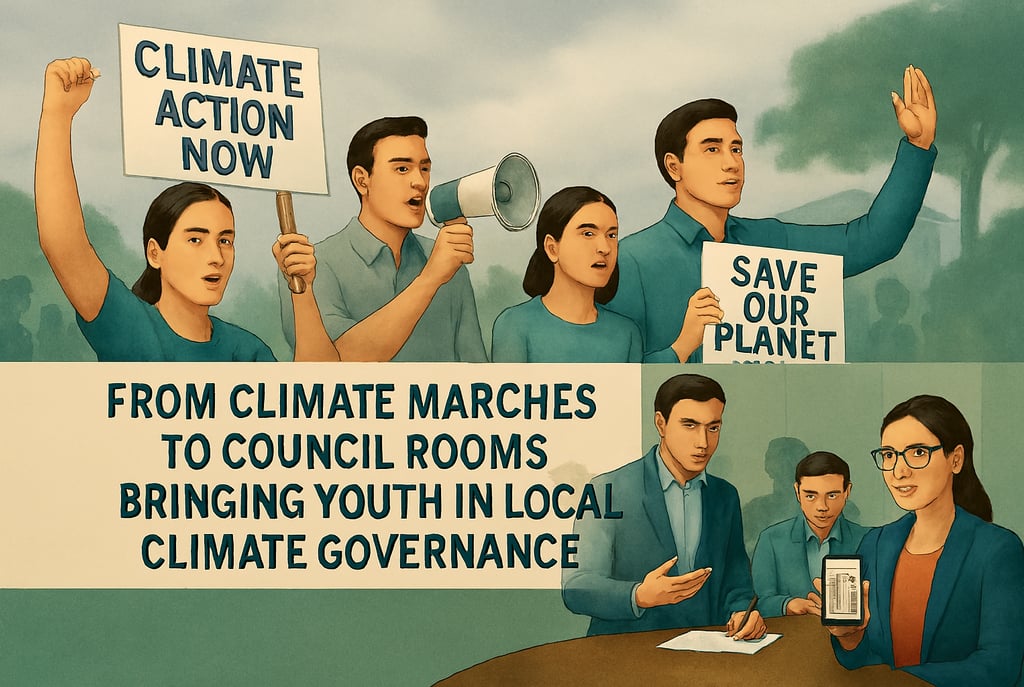YUVA AUR PRAKRTI KE SATH
From Climate Marches to Council Rooms: Bringing Youth into Local Climate Governance
Blog post description.
YOUTHENVIRONMENTGOVERNANCE
Aniket Rathi
2/7/20242 min read


Across Indian cities and towns, students march against air pollution, coastal erosion, and heatwaves. Yet when local governments actually draft disaster plans, build flood defences, or zone new green areas, youth voices are largely missing. This disconnect weakens both policy and participation.
With India’s urban population projected to reach 600 million by 2036 (Census projections), and climate risk rising sharply — average annual heatwave days in India rose by over 150% between 1980–1999 and 2000–2019 (IMD data) — involving youth isn’t symbolic. It’s essential for survival.
Why Local Governments Matter for Climate Action
While national targets (like India’s Net Zero by 2070) get headlines, practical adaptation and resilience — drainage systems, early warning networks, tree canopy plans — happen locally:
Municipalities approve new construction in flood-prone zones.
Panchayats manage water bodies, local forests, and disaster shelters.
Ward committees can prioritise heat action plans or create green corridors.
Yet most local climate strategies in India remain expert-driven, with little structured input from the demographic most exposed to long-term climate risk: youth under 25, who make up nearly 41% of India’s urban population (Census 2011).
Global Models for Youth Inclusion
Internationally, cities have begun to institutionalise youth participation in local climate policy:
London Youth Climate Assembly (2021): 50 residents aged 16–25 debated and formally recommended climate actions to the Mayor and London Assembly.
New York City: A youth advisory council feeds directly into the Mayor’s Office of Climate & Environmental Justice.
Seoul: Youth representatives sit on the Seoul Climate Change Response Committee, helping shape adaptation strategies.
These bodies aren’t ceremonial. They review draft policies, propose pilot projects, and monitor implementation.
Indian Precedents & Gaps
Some Indian states have youth-led environmental clubs (e.g., Sikkim’s eco-clubs) or student-led afforestation campaigns. But these rarely connect to official planning or budget processes. Even large cities often draft climate action plans with consultants and senior officials, not young residents.
A 2022 NIUA study of Indian cities’ climate action plans found less than 5% mentioned structured youth engagement.
Why Structured Youth Participation Matters
Involving youth directly can:
Bring lived experience of heat stress, poor air quality, and unsafe commutes into planning.
Foster local accountability: youth councils can track targets and question delays.
Build skills and ownership: engaging students in planning and budgeting grows civic habits beyond protest.
How Local Governments Could Act
Youth Climate Councils: Official advisory bodies linked to city environment departments or ward committees.
Participatory Green Budgeting: Allow students and local youth groups to help allocate funds for parks, water bodies, or cooling corridors.
Climate Internships: Partner colleges with municipal departments so students work on vulnerability mapping or policy drafts.
School-based Climate Policy Labs: Let students research local adaptation solutions and present them to councils.
Transparent Dashboards: Publish ward-level data on heat action plan progress, tree cover, and emissions — accessible to schools and colleges.
Beyond Protests: Building Pathways to Policy
Marches and petitions remain vital democratic tools. But without structured institutional pathways, youth risk staying outside the decision-making room — heard but not heeded.
India’s next generation will face the sharpest climate impacts. Giving them real seats at local tables isn’t just a gesture. It’s a democratic investment in smarter, fairer, and more accountable climate governance.
